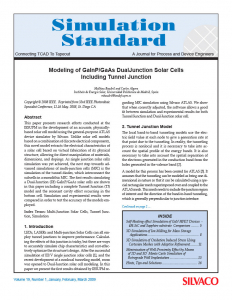Modeling of GaInP/GaAs DualJunction Solar Cells Including Tunnel Junction
Mathieu Baudrit and Carlos Algora
Instituto de Energía Solar, Universidad Politécnica de Madrid, Spain
mbaudrit@iesdef.upm.es
Copyright © 2008 IEEE. Reprinted from 33rd IEEE Photovoltaic Specialist Conference, 12-16 May. 2008, St. Diego CA
Abstract
This paper presents research efforts conducted at the IESUPM in the development of an accurate, physically-based solar cell model using the general-purpose ATLAS device simulator by Silvaco. Unlike solar cell models based on a combination of discrete electrical components, this novel model extracts the electrical characteristics of a solar cell based on virtual fabrication of its physical structure, allowing for direct manipulation of materials, dimensions, and dopings. As single junction solar cells simulation was yet achieved, the next step towards advanced simulations of multi-junction cells (MJC) is the simulation of the tunnel diodes, which interconnect the subcells in a monolithic MJC. The first results simulating a Dual-Junction (DJ) GaInP/GaAs solar cells are shown in this paper including a complete Tunnel Junction (TJ) model and the resonant cavity effect occurring in the bottom cell. Simulation and experimental results were compared in order to test the accuracy of the models employed.
Index Terms: Multi-Junction Solar Cells, Tunnel Junction, Simulation
1. Introduction
LEDs, LASER and Multi-junction Solar Cells can all employ tunnel junctions to improve performance. Calculating the effects of this junction is tricky, but there are ways to accurately simulate chip characteristics and cost-effectively optimize the structure’s design. After the successful simulation of III/V single junction solar cells [1], and the recent development of a nonlocal tunneling model, room was opened to Dual-Junction solar cell modeling. In this paper we present the first results obtained by IESUPM regarding MJC simulation using Silvaco ATLAS. We show that when correctly adjusted, the software allows a good fit between simulation and experimental results for both Tunnel Junction and Dual-Junction solar cell.



